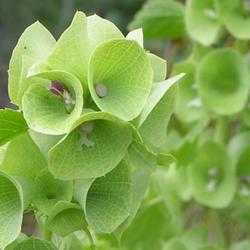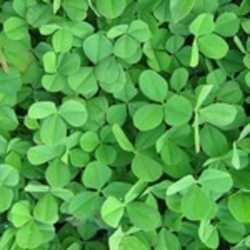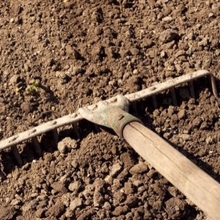 Name
Name
Its scientific name, Moluccella laevis, is also something of a misnomer -- Linnaeus was mistaken in his belief that the plant originated from Indonesia’s Molucca Islands. This mint family member is in reality native to the eastern Mediterranean countries of Syria and Turkey. Not surprisingly, given its lucky-charm color and Irish name, bells-of-Ireland represents good luck in the language of flowers. Description
Description
Bells-of-Ireland grows on square stalks that reach up to 2 to 3 feet in height, measuring no more than 9 inches across. Each strong stem features dense clusters of papery, bell-shaped calyxes, or modified leaves. The bells’ color may vary from pale celadon to a green bright enough to rival a Granny Smith apple. Small rounded and serrated leaves grow from the sides of the stalks, and a pair of small, sharp spines lies beneath every calyx. The plant’s lightly fragrant white flowers lie like tiny clappers in the center of each bell. Uses
Uses
Bells-of-Ireland has a stately yet informal appearance, making it look right at home in a cottage garden. The stalks provide a welcome vertical accent in the rear of a border. Once cut, the stems are particularly long-lasting, making them popular for use in a vase. The cool green bells contrast beautifully with flowers of any color and add drama to arrangements. They look especially lovely when paired with flowers of white or soft pastels like pink, peach or pale yellow or blue. As they dry, green bells-of-Ireland fade to a delicate beige color. They combine well with other dried flower materials, particularly grasses and seed pods. Culture
Culture
Plant bells-of-Ireland in moist, well-drained soil in a location where it will receive full to mostly full sun. It does best in areas with warm, mild summers, and will not fare as well if exposed to drought or very hot and humid conditions. For such a tall plant, bells-of-Ireland matures relatively quickly and will reliably produce stalks from the middle of summer to frost.
You can encourage the height of the stalks by watering and fertilizing the plants regularly. Bells-of-Ireland will look its best where it receives some protection from the wind; tall stalks may require staking. This plant is a good choice if you have a problem with deer or rabbits, since neither animal is likely to bother it.
Starting From Seed
Sow the seeds outdoors after all danger of frost. You can get a head start on spring planting by sowing seeds indoors 8 to 10 weeks before the last expected frost. The seeds require light to germinate, so leave them only lightly covered with soil. If you live in a warm area and wish to enjoy an autumn harvest of the flower, sow seeds again in August. Under ideal conditions, the plant often self-sows. Space plants 9 to 12 inches apart.![]() Drying
Drying
For best results in preparing bells-of-Ireland for use as a dried flower, use only stalks on which all the bells have fully opened. Cut away any leaves, then hang the stalks upside down in a dark, dry and warm location. They will dry completely within 2 to 3 weeks.
Suggested Reading:
University of Wisconsin Cooperative Extension: Bells of Ireland, Molucella Laevis
Images:
thumbnail photo by sarowen
bells-of-Ireland with monarda by dalemcneill
line drawings from Florida Center for Instructional Technology

















